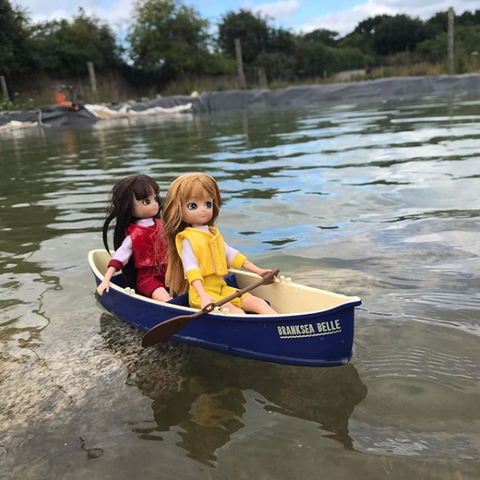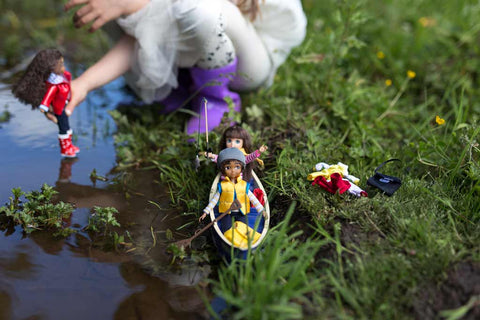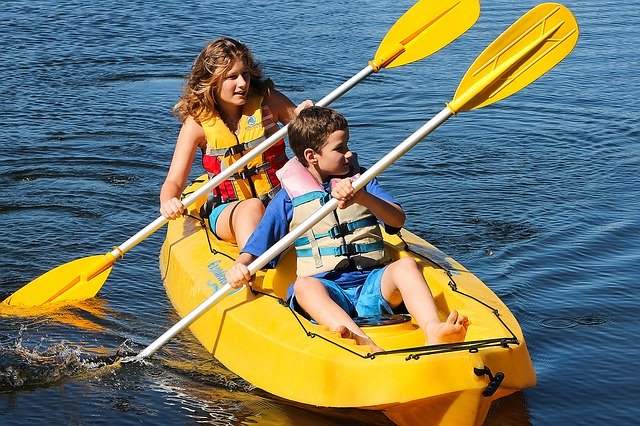Trying out a new water sport can be a fun and engaging way to get your kids active in the great outdoors. If you’ve ever wanted to give kayaking a try, here is a handy guide to kayaking with kids – with the basic things you’ll need to know for staying safe and having a blast!
Quick Safety Tips
Any activity on or around the water can be dangerous without the proper knowledge or equipment. Taking the proper safety precautions when kayaking with kids will help everyone have a great time.
-
Kids First – Always keep your children where you can see them. For younger children in a tandem kayak, have them sit in front of you (or in between, if your kayak is designed for more than two people). Older children paddling their own kayaks should take the lead while in the water. This keeps them safely in view, but also gives them a fun chance to assert their independence!
-
Practice a Wet Exit – If you’re using sit-in kayaks, practice a wet exit in a safe area. Take lessons if you need to, but this is a necessary skill for staying safe if your kayak tips.
-
Tow lines and float bags. Remember to pack tow lines and float bags, just in case you need to give a tired kid’s kayak a tug home.
-
Personal Flotation Devices – Always wear a properly fitted personal flotation device or lifejacket when participating in boating activities.
Always wear your lifejacket!
Whenever you’re participating in water sports in and around the water, always wear a PFD or personal flotation device (lifejacket). This is especially true for children, but you should wear one too! These life-saving devices keep you afloat if you’ve been tipped from your kayak, and make you much easier to rescue.
Make sure your child’s lifejacket fits properly and that it is in good condition. Children grow quickly, so check their lifejackets before they get into the water. Children’s lifejackets generally come in three sizes: Infant (8-30 lbs/3-14 kgs), Children (30-50 lbs/14-23kgs), and Youth (50 -90 lbs/23-40kgs). Some jackets are adjustable at the shoulders and sides so you don’t have to replace them every year.

Best Kayaks for Kids
Kayaks are small, narrow boats that seat one or two paddlers. They are small and maneuverable, and perfect for exploring lakes, rivers, or even tackling white-water rapids or ocean waves. Kayaks come in many styles and sizes, but not all of them will be appropriate for your family’s needs.
Sit-in vs Sit-on
For “sit-in” styles of kayaks, your legs are covered. They can be harder to escape if they tip, and may be too big for children to maneuver on their own.
“Sit-on-top” style kayaks are perfect for beginners. They’re also great for casual paddling because you can stop, jump off for a swim, and climb back on pretty quickly.
Single or Tandem
For children under 10, consider paddling with your child on a tandem kayak. If your child is a competent paddler and a good swimmer, they can move on to their own single kayak – but don’t forget the tow rope, just in case.
Proper Paddling Technique
Each person will need a paddle. Children’s paddles will be lighter and thinner, and therefore more easy to maneuver and use. Practice proper paddling techniques on dry land. There are many YouTube videos and articles you can read (or take a lesson with a pro!) to perfect your technique, but you can learn the basics here.
Kayaking with Kids Gear Checklist
The type and quantity of kayaking gear you’ll need will vary depending on the type of trip you’re planning, but it’s better to be prepared. Double-check your list and examine all of your gear before you shove off from shore.
Kayaking Checklist:
- PFDs for each person. Make sure they fit and are in good repair.
- Paddle floats, throw bags, bilge pumps for each kayak
- Change of clothing in a waterproof bag
- Water shoes
- Rain gear
- Dry bags for phones, cameras, etc.
- First-aid kit
- Food and water
- Sun protection
- Fun!
Keep Kids Fed and Hydrated
Most kayaks are equipped with some storage space for a cooler that can be secured with bungee cords. Consider packing your child’s favorite high-protein snacks, and they’re less likely to complain about being hungry.
When it comes to hydration, pack more water than you think you’ll need. Despite being surrounded by water, it’s easy to get dehydrated while boating. Check out this article to figure out how much to bring with you.
Prevent Painful Sunburns
Clothing offers more protection than sunscreen alone, but still make sure to reapply at least every two hours (especially on the chest and neck area). Make sure your kids are adequately protected from the sun with sun hats, sunscreen, sunglasses, or long-sleeved shirts. You can also purchase specific clothing that contains SPF.

Don’t forget the fun!
Depending on where you’re going, think of a few activities that can keep your kids entertained. Consider bringing a few things that can keep your kids busy while you stop for a rest: fishing gear, a small net, shovel, bucket, beach towels, etc.
Where to Go Kayaking with Kids
While adventure may be calling to you on the open ocean, it’s better for new kayakers to practice their paddling on a quieter body of water first. Lakes or large ponds provide ample opportunity to grow your skills, especially if your kids are new to the sport too. Once you’re comfortable with calm bodies of water, then you can consider handling areas with stronger currents.
Kayaking Tips
If you’re feeling a bit overwhelmed by all the information available, here are some quick tips:
- Visit a sporting goods store or specialty boating store. They have professional staff members who can help answer your questions and get you outfitted with the right gear.
- Consider taking lessons. The best way to learn is from a professional who can provide hands-on experience and advice.
- Try before you buy. If you’re not sure you want to fully commit to the sport, many lakes and rivers offer kayak rentals.
Focus on the fun. If all your kids want to do is paddle around a small inlet and look for shiny rocks, then it’s perfectly okay to do that. Be safe, but have fun!
![]() Fast Shipping
Fast Shipping![]() Subscribe to our Newsletter
Subscribe to our Newsletter![]() 🌟 New Global Competition 🌟
🌟 New Global Competition 🌟













